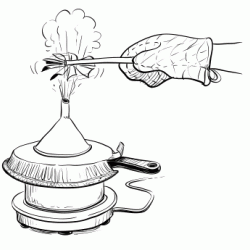Source Institutions
Source Institutions
Add to list Go to activity
Activity link broken? See if it's at the internet archive

In this activity, learners explore how various energy sources can be used to cause a turbine to rotate. Learners will construct a turbine that is not strong enough to operate an electrical generator, but will show how the force of wind, water, and steam are used to make the turbine spin. During this experiment, learners will use the scientific method to write up their work, including hypothesizing and drawing conclusions. This activity is intended for use in conjunction with the activity "Getting Current" from the same resource (see related resources). However, this activity is designed to stand alone, if necessary. Note: this activity involves working with heat and steam (hot plate).
- 45 to 60 minutes
- 1 to 2 hours
- $1 - $5 per group of students
- Ages 8 - 14
- Activity, Experiment/Lab Activity, Lesson/Lesson Plan, Model
- English
Quick Guide
Materials List (per group of students)
- 2 aluminum pie pans
- Metal funnel, 4 inches (10 cm) in diameter
- Scissors
- Compass (for drawing circles)
- Ruler
- Pencils
- Several plastic straws (the long soda type is best, but regular sized straws can be used)
- Push pins
- Small cooking pot, no bigger than 5 or 6 inches (13-15 cm) in diameter
- Student Handout, “Going for a Spin,” pages 4-7
- Copy of Chapter 2 Discussion, “Energy and Electricity”
- Student Handout, “Scientific Method Form,” page 3 of the Appendix
- Hot plate(s) or other heat source(s)
- Oven mitts
- Source(s) of falling water, such as a faucet and sink, or a large jug or bottle of water and a bucket or tub
- Towels for clean-up
- Small, thin washer (optional)
Subjects
-
Engineering and Technology
-
Engineering
- Electrical Engineering
- Environmental Engineering
- Technology
-
Engineering
-
Physical Sciences
-
Heat and Thermodynamics
- Heat Transfer
- Thermodynamics and Entropy
- Electricity and Magnetism
-
Energy
- Work and Machines
-
Motion and Forces
- Machines
- Rotation Motion
-
States of Matter
- Changes of Phase
-
Heat and Thermodynamics
-
Mathematics
-
Data Analysis and Probability
- Data Analysis
- Data Collection
- Data Representation
-
Measurement
- Circles
- Reasoning and Proof
- Representation
-
Data Analysis and Probability
-
The Nature of Technology
-
Technology and Society
- Technology and the Environment
-
Technology and Society
-
The Nature of Science
-
The Scientific Process
- Asking Questions
- Conducting Investigations
- Gathering Data
- Formulating Explanations
- Communicating Results
-
The Scientific Process
Informal Categories
- Model Building
- Nature and Environment
Audience
To use this activity, learners need to:
- see
- read
- touch
Learning styles supported:
- Involves teamwork and communication skills
- Involves hands-on or lab activities
Other
Components that are part of this resource:
Includes alignment to state and/or national standards:
Includes assesments for student learning:
This resource is part of:
Access Rights:
- Free access
By:
- Nemzer, Marilyn ; Page, Deborah ; Carter, Donna
Rights:
- All rights reserved, The California Study, Inc., 2010
Funding Sources:
- Geothermal Energy Association
- ORMAT
- Calpine
- US Geothermal Inc.
- GeoPower Americas
- Foundation for Water & Energy Education
